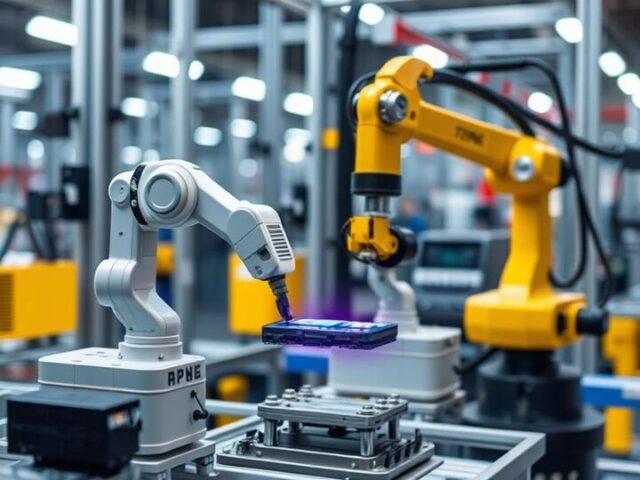Changes in modern manufacturing have been driven by rapidly advancing technologies. This sea change within modern manufacturing and automation is reshaping not only how goods are produced but also what work is to be undertaken. This paper discusses various standpoints of automation: the benefits, the challenges, and the exciting prospects that this technology has opened toward the future of industry.
What is automation in contemporary manufacturing?
Automation in contemporary manufacturing involves the use of technology with the intention of operating the process of production with minimal human functions and interference. Examples range from basic forms of automation to higher integrations involving robotics, artificial intelligence, and machine learning for higher scales of technological coverage. For example, car factories use robots to weld down production lines, and automated systems are used for sorting at processing plants.
Types of Automation
Automation is not a one-size-fits-all proposition. Several different kinds achieve a variety of needs:
- Fixed Automation: Specialized equipment is set up to perform a particular task. A good example is a conveyor belt moving products down an assembly line. This type of automation is efficient in high-volume production but offers little flexibility for changes.
- Programmable Automation: Computer-driven equipment, including robots, is used in automobile manufacturing. Examples of this type are easily reprogrammable for another product; thus, they are flexible.
- Flexible Automation: This involves highly sophisticated software and sensors to make the needed adaptations. For example, a robotic arm can change its motion according to the size and shape of the product it is dealing with.


Advantages of Automation in Modern Manufacturing
Modern manufacturing automation has several major and undeniable advantages, which compel manufacturers to embrace it. Some of these advantages include:
- Increased Efficiency and Productivity: Automated systems can work 24/7, do not take breaks, and do not get fatigued, hence giving much higher production output. Automated processes often run faster and more precisely than manual labor, resulting in increased efficiency.
- Improved Product Quality: Automation minimizes human error and therefore allows the realization of a high and constant quality of product. Machines can assume more routine tasks since they are more precise than human beings, reducing defects and improving overall quality.
- Improved Safety: Manufacturing can be hazardous. It lessens the need for employees to be exposed to dangerous activities, making the workplace much safer. Machines can weld, paint, or even move heavy material around to avoid placing workers in dangerous areas.
- Reduced Costs: While it involves a higher initial investment in setting it up, automation generally pays itself off through cost savings in production over time. It cuts labor costs by enhancing efficiency and reducing waste, thus bringing down the overall cost of production.
- Increased Flexibility: Modular automation systems, such as flexible automation, are designed to accept product design changes and production volume variations. This allows manufacturers to adapt to ever-changing marketplace dynamics and customer demand.
Examples of Automation in Modern Manufacturing
Many examples of it can be seen in manufacturing across industries:
- Automotive: Robots assemble cars, paint them, and even inspect for quality.
- Electronics: Machines manufacture circuit boards, assemble parts of electronic equipment, and test the finished product.
- Food and Beverage: Computer-controlled systems manufacture food, package products, and control inventory.
- Pharmaceuticals: Sterile production processes are done by robots; medications are packaged and distributed.
- Textiles: Automated looms weave fabric; robotic systems cut and sew garments.

Automation and Its Impact on the Workforce
Automation within today’s manufacturing process has raised anxiety about its effect on job security. While some jobs will be replaced, many new job opportunities will be created since it encompasses a variety of skilled individuals in the design and maintenance of such automated systems.
Replacement and Creation of Jobs
While some manual, monotonous jobs are taken over by machines, new avenues relating to robotics, software development, and data analysis open up. This implies a need for investment in education and training that equips laborers for an uncertain future.
The Nature of Work Changes
Automation is changing the nature of work within manufacturing. Instead of doing jobs by hand, the workforce is increasingly composed of supervisors and technicians commanding and interacting with automated systems. This, in turn, calls for problem-solving, critical thinking, and technical skills.
Future of Automation in Modern Manufacturing
With continuous development in robotics, machine learning, and AI, the nature of it keeps changing in modern manufacturing.
Industry 4.0
Industry 4.0 refers to a “smart factory” where the levels of connectivity and automation are very high—integrating several technologies, including the Internet of Things, cloud computing, and big data analytics, into one seamless system for manufacturing goods.
Artificial Intelligence and Machine Learning
AI and machine learning are emerging impetuses for automation, enabling artificially intelligent systems to learn, make decisions on data, adapt to real conditions, and improvise changes immediately, creating new possibilities within this complex and continuously changing manufacturing environment.
Collaborative Robots (Cobots)
Cobots are designed to augment human ability, not replace it. They are smaller, safer, and relatively easier to program than industrial robots, so they tend to be applied to much broader areas.


Challenges of Automation
Implementing automation comes with its own set of challenges:
High Initial Investment
This normally requires a huge upfront investment in machinery, software, and training, creating an entry barrier for smaller manufacturers.
Cybersecurity Risks
Interconnected and automated systems are susceptible to cyber threats, requiring robust security measures.
Ethical Issues
The level of ethical consideration regarding job losses and potential bias in AI-driven systems rises with the amount of automation.
Automation is no longer a fad; it is ushering in a sea change in the industrial world. Despite the difficulties, the benefits in regard to efficiency, quality, and safety are apparent. Automation opens a new world for productivity, innovation, and competitiveness for manufacturers. With automation, success ensures a bright future for manufacturers.







































Leave a Review